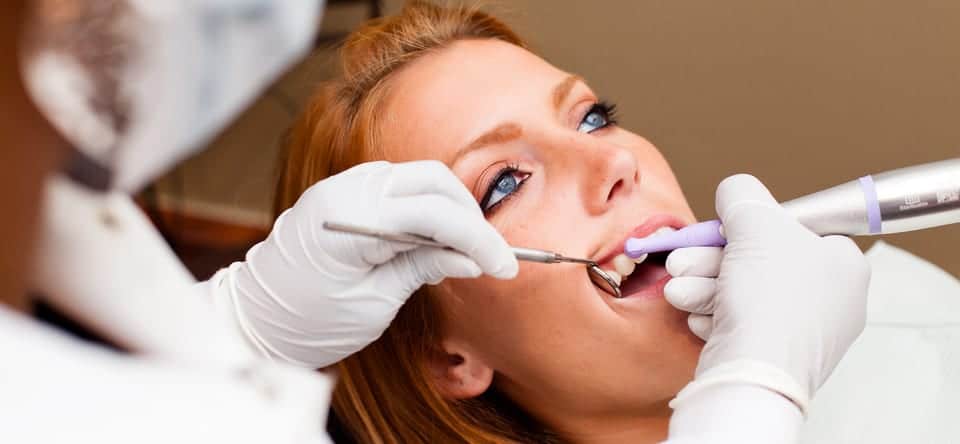Bleeding gums:If you have bleeding gums, chances are you have a local cause for that. something wrong happening with your gums. Indeed it might mean something more sinister, like Leukemia, or other blood disorders, but we need to investigate the local conditions first. So if your gums bleed, that is not normal. It is the first sign you have problems with your gums. Gum diseases are collectively called Periodontal diseases. The whole process starts when you eat and produce saliva (all normal), the germs in your mouth start forming a layer on teeth surfaces. This layer is called dental plaque and consists of germs, mucus, food debris, by-products from the germs, and a protein layer. If this layer of dental plaque is not removed, it will eventually develop into calculus (also called Tartar). The mechanism of forming calculus is not fully understood yet. They are very similar to gall bladder stones, or even kidney stones. We can call them gum stones for simplicity. The home-care procedures are very important to break this cycle. Unfortunately, it only slows it down, but you will not get rid of the dental plaque between your teeth without having them professionally cleaned at the dentist, at least once every 6 months. Stages of Periodontal disease:– Gingivitis, which is simply the inflammation of the gums. It is caused by the dental plaque and calculus on your teeth, which act as scaffolding for germs to attack your gums. This stage is usually easily managed, it just needs dental scaling to remove the calculus build up from your teeth and follow a home-care regime. As the gums get inflamed, they get engorged with blood, hence they bleed with any provocation, like a tooth brush. The calculus is simply petrified dental plaque. Calculus starts getting bigger and thicker. which enables the germs to reach more areas, especially under the gum line. Normally there is a pocket (called Sulcus) between your gum and tooth at the depth of 2-3mm. The germs get access to the sulcus using calculus build up. Germs start producing toxins that break down the attachment of the gum to the tooth surface, and the gums respond with more inflammation and swelling. So the sulcus gets deeper and the gums swell up. The sulcus is known as periodontal pocket, and can reach to 10mm in depths. In the gingivitis stage, a periodontal pocket might be present, and it is called a pseudo-pocket (because the depth of the suclus gets increased by the swelling of the gums only, but not the breakdown of the tooth-gum attachment). The breakdown of the gum-tooth attachment heralds the second stage of periodontal disease: – Early Periodontitis: Periodontitis simply means inflammation of the tissues around the tooth. In this stage it involves the periodontal ligament. The gums seem bigger than usual and bleed more easily. at this stage deep scaling is needed, where the ultrasonic scaler needs to reach under the gum to remove all te deposits and build up. – if not treated the condition enters the next stage: – Advanced Periodontitis. Once the inflammation reaches the bone around the tooth, the bone itself starts to respond by inflammation and breakage, which makes the pockets even deeper. Teeth start to feel loose. Prognosis for the teeth starts to get worse. Treatment will involve surgical cleaning and regular maintenance. – once bone breakdown starts, the condition is probably not reversible. There are some new products that have promising results. Some target the under-the-gum tartar to dissolve it. Another product is a combination of bone-gum tissue graft, that might help the regeneration process of the lost tissues. We conclude from this, that Periodontal disease is caused by local factors, but there are other factors that increase the risk for gum disease, and can cause bleeding gums: – Certain diseases: Heart problems, Diabetes, blood and bleeding disorders. Uncontrolled Diabetes: this causes delayed healing, unresponsive white blood cells (which are, our immune system). Elevated levels of Periodontal disease also lead to complications in management of blood glucose levels. This disease, tends to be more prevalent, and more severe in diabetic patients than in the general population. This is mainly due to the fact that diabetics have decreased wound healing and infection fighting ability. – Diet: Vitamin C, and Vitamin K deficiencies can cause bleeding gums. – Medication: high blood pressure medication, Aspirin, anticoagulants. – Pregnancy. Hormonal changes during pregnancy make the gums react in an exaggerated manner to inflammation, making them bleed easily. – Misaligned teeth: these makes it easier for germs to attach to tooth surface, and form plaque and calculus. It is also more difficult for the person to clean. – Dentures: dentures provide more surface for germs to attach to. Partial dentures have clasps that are very inviting for germ to form plaque on the tooth surface. – Rough fillings. If you have a rough filling, this makes it easier for germs to adhere to the tooth surface. – Braces: these are another platform for germs to use in forming more plaque on teeth. Management of periodontal disease: – prevention is the key here. Advanced periodontal disease has poor prognosis. Through out this article, the word pain has never been mentioned. This is important, periodontal disease is often painless, and most people who get diagnosed with even the advanced stages of it, are totally oblivious, and get surprised when told they have a serious problem in their mouth. – Make sure to brush twice daily and floss at least once. – use mouth rinses every other day. – diet rich in vitamins, and proteins. In general healthy diet. – Fish oil also help eliminate the early stages of gum disease. Conclusion:Peirodontal disease is a serious condition if you are serious about keeping your teeth. No one is immune against it. Most important thing to remember is: Prevention, prevention, prevention.
0 Comments
Implants are one of the options to replace a missing tooth or a number of teeth. This article summerises the steps involved in replacing a single missing tooth with an implant. Step 1: Diagnosis, taking records, like photographs, radiographs, and study models. These records guide us for the coming surgery. It might show the need for any bone graft prior to the procedure. The study model will be used to fabricate a surgical guide. Step 2: Surgery, this step involves cutting the gum, drilling the bone where the tooth will be placed. An implant is placed in the bone. This piece is called a “Fixture”. Depends on strength of bone, this implant might be covered with gums and left to heal for up to three months, or the next step might be done simultaneously. Step 3: There is a piece that is screwed to the fixture, it is called an abutment. Two abutments are usually used, a “Healing Abutment” which is placed to allow the gums to heal around the implant. Then a “Definite abutment” is placed. Step 4: The healing abutment is removed. An impression is taken to record the position of the implant. The dental technician will send two pieces to the dentists, the definite abutment which is screwed to the fixture, and a crown (cap) which is either cemented or screwed to the abutment. Step 5: Follow up and care. Implants can fail years down the track due to lack of proper care. This involves brushing like natural teeth and having the hygienist or the dentist do proper scaling around the neck of the tooth. Conclusion:Replacing a missing tooth with an implant involves many steps. These steps might vary from one person to another bu the main concept is the same.
When it comes to oral health, females are the unlucky gender. The female body goes through hormonal shifts that affect the oral health. Hormones affect our body chemistry, so it is only expected that they should affect the oral tissues as well.  Female hormonal changes affect the gum conditions. These changes are not the cause for bad breath, or gum disease, but they exaggerate an existing condition. Most people have some degree of gingivitis, so when this gets exaggerated by hormonal changes the effects can be very pronounced. The female hormones change the vascularity of the gums, that is, they increase the number of small blood vessels, hence increase the blood flow into the gums. Increased vascularity means the gums tend to bleed easily, also studies showed that it means there is more chance for bacteria to enter the blood stream via these vessels. Gum disease means inflamed gums. As part of any inflammation, the cells release a chemical called Prostaglandin. In severe cases of gum disease this chemical might cause labor and premature birth. These hormonal changes tend to occur throughout life, during puberty, menstruation, pregnancy, menopause, and by using birth control pills.  Symptoms that occur during these hormonal changes: – Bleeding gums. – redness or tenderness in the gums – Teeth sensitivity. – Bad breath. – Flakes of calculus coming off teeth. – Increased chances for sores and blisters on the lips. – Developing a tumour. During pregnancy in sever cases, the inflamed gum might forma growth called Pregnancy Tumour. It is benign and not a cancer, but very annoying and will require surgical removal. – Dry mouth – Xerostomia. This is probably related to the hormone Estrogen which increases after menopause. – Bone loss. Once again Estrogen might play a part here, making bone less dense, this causes bone loss followed by gum recession. This might lead to root decay, or even loose teeth. – Altered taste sensation. – Burning mouth syndrome. What to do: – Maintaining healthy gums by following regular oral health is the key. – Take extra special care during pregnancy, and bare in mind that regular dental exams during pregnancy are not only completely safe, but are highly recommended by both dentists and physicians alike. – Plan your pregnancy and make sure to include a visit to the dentist and carry out any work needed before concieving. Conclusion:Extra challenges are placed on oral health for women due to hormonal changes. Make sure to keep your gums healthy by maintaining a diligent care at home, visit us regularly for check ups and cleans, use fluoride rinse. While brushing, have you ever noticed a bit of blood on your toothbrush and wondered about the cause? Everyone’s gums bleed at some point in their lives for a variety of reasons, but the sight of a little red while you brush can still be unnerving. Gums, or gingiva, are the pink tissue that cover your jawbone and hold your teeth in place. Healthy gums are firm, taut and surround each tooth. Of course, there are multiple reasons why your gums may start leaking red, and none of them are comfortable. To help make sure your gums are as healthy as possible, we’re going to list five of the leading reasons why gums bleed and what you can do to remedy the situation. First, we’ll talk about the most common cause of bloody gums, but luckily, it’s the easiest to fix! 1- Poor oral hygiene1- The leading cause for bleeding gums is poor oral hygiene. Your cleaning regimen needs to include more than just brushing, as brushing alone won’t remove all the plaque, tartar and calculus that accumulates on your teeth at the gum line. Flossing daily isn’t an option, but a necessity. Keeping your mouth and teeth clean and disease-free is not a one size fits all protocol. Brushing at least twice a day is a must for everyone, but if your gums have recently started bleeding, try brushing after every meal. Your gum health will likely improve, and you’ll probably see difference in how often your gums bleed. 2- GingivitisSounds complicated, but it just means that your gums are inflamed. However, if it’s not taken care of, gingivitis can become a serious issue. It’s a chronic condition caused by the long-term effects of plaque — a sticky material made of bacteria, mucus and food debris — and tartar (what plaque becomes when it hardens) build up. Most of us have some degree of gingivitis from time to time, but consistent dental care can turn it around. Plaque can be easily removed with brushing and flossing, but tartar requires a trip to the dentist, where specialized ultra-sonic cleaning equipment will be used to break it off and allow the gums to heal. 3- PregnancyRegardless what you do, your gums may seem to be bleed more when you’re expecting. It’s called pregnancy gingivitis, and it’s caused by fluctuations in your hormone levels, which increase blood flow to your gums and other tissues. Pregnancy hormones also affect the body’s normal response to bacteria, leaving you more susceptible to periodontal infections. So what’s a girl to do when faced with pregnancy gingivitis? First, see your dentist for an additional cleaning, and discuss any problems you might have. You also may want to consult with your OBGYN. Next, switch to a softer toothbrush, brush at least twice a day, and floss at least once a day. This won’t avoid the problem altogether, but a bit of TLC with your gums during pregnancy will go a long way! 4- Periodontal diseasePeriodontal disease occurs when gingivitis is left untreated. While gingivitis is restricted to the gums, periodontal disease spreads into the tissue and bone that support the teeth. Instead of having gums that bleed from time to time, periodontal disease causes gum tissue to always be raw and have the appearance of pulling away from your teeth. In developed cases, you may notice pus in between your teeth and around your gums. If left untreated, periodontal disease can spread to the point where you could lose some — or even all — of your teeth. To avoid this scenario, practice good oral hygiene, eat a balanced diet and don’t smoke or chew tobacco. Even with proper daily dental care, using tobacco can put you at increased risk of gingivitis and periodontal disease. 5- Bleeding disordersBleeding gums can be the first sign of something more serious. This can be diagnosed by eliminating the other causes of bleeding. If all local causes of bleeding gums are taken care of, but you are still bleeding, especially if it is associated with other symptoms like nose bleeds, talk to us, we may refer you to a specialist. ConclusionWhatever the reason for your bleeding gums, it’s important to get to the root cause of the problem. Yes, it could be a symptom of a more serious underlying issue, but no matter what, it’s uncomfortable and needs to be taken care of. Make an appointment to see us as soon as you start seeing red.
|
AuthorArticles are written by Dr M Hajarat. Archives
July 2024
|
|
Niagara Park Dental
3 / 16 Washington Avenue Niagara Park, NSW 2250 Email: [email protected] Phone: (02) 4329 3003 |
HOURS
Mon 9:00 - 5:30 Tue 9:00 - 5:30 Wed 9:00 - 5:30 Thu 9:00 - 5:30 Fri 9:00 - 5:30 |
|









